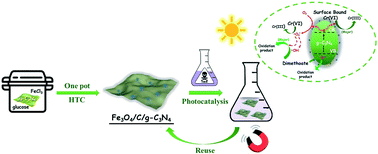当前位置:
X-MOL 学术
›
Catal. Sci. Technol.
›
论文详情
Our official English website, www.x-mol.net, welcomes your feedback! (Note: you will need to create a separate account there.)
Simple fabrication of Fe3O4/C/g-C3N4 two-dimensional composite by hydrothermal carbonization approach with enhanced photocatalytic performance under visible light†
Catalysis Science & Technology ( IF 5 ) Pub Date : 2018-05-18 00:00:00 , DOI: 10.1039/c8cy00698a Xing Ding 1, 2, 3, 4 , Dong Xiao 1, 2, 3, 4 , Lei Ji 1, 2, 3, 4 , Ding Jin 1, 2, 3, 4 , Ke Dai 2, 3, 4, 5 , Zixin Yang 1, 2, 3, 4 , Shengyao Wang 1, 2, 3, 4 , Hao Chen 1, 2, 3, 4
Catalysis Science & Technology ( IF 5 ) Pub Date : 2018-05-18 00:00:00 , DOI: 10.1039/c8cy00698a Xing Ding 1, 2, 3, 4 , Dong Xiao 1, 2, 3, 4 , Lei Ji 1, 2, 3, 4 , Ding Jin 1, 2, 3, 4 , Ke Dai 2, 3, 4, 5 , Zixin Yang 1, 2, 3, 4 , Shengyao Wang 1, 2, 3, 4 , Hao Chen 1, 2, 3, 4
Affiliation

|
The construction of a multifunctional two-dimensional (2D) composite photocatalyst is of great significance because such a composite can exhibit enhanced catalytic performance and improved practical usability in contrast to a single component catalyst. Herein, a ternary photocatalyst composed of g-C3N4, a carbon layer (C), and Fe3O4 nanoparticles was successfully synthesized by a facile one-pot hydrothermal carbonization (HTC) method from g-C3N4, glucose, and FeCl3. The resultant composite, Fe3O4/C/g-C3N4, had an ordered 2D heterostructure and exhibited enhanced visible-light-driven photocatalytic performances and good magnetic recyclability. The kobs for Cr(VI) photoreduction (or dimethoate photodegradation) over Fe3O4/C/g-C3N4 was 20.9-fold (or 2.1-fold) of that over g-C3N4. Comparative study of Fe3O4/C/g-C3N4, C/g-C3N4, and g-C3N4 on their optoelectronic properties revealed that this enhanced photocatalytic activity was mainly due to rapid photogenerated electron transport from the g-C3N4 component to carbon and/or Fe3O4, which effectively suppressed the recombination of photogenerated electrons and holes. In addition, the good surface adsorption capacity of the carbon component towards Cr(VI) also contributed to Cr(VI) photoreduction over Fe3O4/C/g-C3N4. Finally, a reasonable photocatalytic reaction mechanism of Fe3O4/C/g-C3N4 was proposed based on the results of trapping experiments. This study is not only limited to developing a high-performance g-C3N4 based photocatalyst, but also expected to provide a green, facile, and cost-efficient strategy to combine 2D materials with a carbonaceous layer and other functional components for a multifunctional system.
中文翻译:

通过水热碳化法 简单地制备Fe 3 O 4 / C / gC 3 N 4二维复合材料,并在可见光下增强了光催化性能†
多功能二维(2D)复合光催化剂的构建具有重要意义,因为与单组分催化剂相比,这种复合物可以表现出增强的催化性能和改善的实用性。本文中,由gC 3 N 4,葡萄糖和FeCl通过一锅法水热碳化(HTC)成功地合成了由gC 3 N 4,碳层(C)和Fe 3 O 4纳米颗粒组成的三元光催化剂。3。所得复合材料Fe 3 O 4 / C / gC 3 N 4,具有有序的2D异质结构,并表现出增强的可见光驱动的光催化性能和良好的磁可回收性。该ķ OBS对Cr(VI超过Fe)的光致还原(或乐果光降解)3 ö 4 / C / GC 3 Ñ 4为20.9倍(或2.1倍)的,超过GC 3 Ñ 4。Fe 3 O 4 / C / gC 3 N 4,C / gC 3 N 4和gC 3 N 4的比较研究关于它们的光电性能的研究表明,这种增强的光催化活性主要归因于从gC 3 N 4组分到碳和/或Fe 3 O 4的快速光生电子传输,这有效地抑制了光生电子和空穴的复合。此外,碳成分对Cr(VI)的良好表面吸附能力也有助于Cr(VI)在Fe 3 O 4 / C / gC 3 N 4上的光还原。最后,合理的Fe 3 O 4 / C / gC 3 N光催化反应机理根据诱集实验的结果提出了4种方法。这项研究不仅限于开发高性能的基于gC 3 N 4的光催化剂,而且还有望提供一种绿色,简便且经济高效的策略,以将2D材料与碳质层和其他功能组件结合在一起,形成多功能系统。
更新日期:2018-05-18
中文翻译:

通过水热碳化法 简单地制备Fe 3 O 4 / C / gC 3 N 4二维复合材料,并在可见光下增强了光催化性能†
多功能二维(2D)复合光催化剂的构建具有重要意义,因为与单组分催化剂相比,这种复合物可以表现出增强的催化性能和改善的实用性。本文中,由gC 3 N 4,葡萄糖和FeCl通过一锅法水热碳化(HTC)成功地合成了由gC 3 N 4,碳层(C)和Fe 3 O 4纳米颗粒组成的三元光催化剂。3。所得复合材料Fe 3 O 4 / C / gC 3 N 4,具有有序的2D异质结构,并表现出增强的可见光驱动的光催化性能和良好的磁可回收性。该ķ OBS对Cr(VI超过Fe)的光致还原(或乐果光降解)3 ö 4 / C / GC 3 Ñ 4为20.9倍(或2.1倍)的,超过GC 3 Ñ 4。Fe 3 O 4 / C / gC 3 N 4,C / gC 3 N 4和gC 3 N 4的比较研究关于它们的光电性能的研究表明,这种增强的光催化活性主要归因于从gC 3 N 4组分到碳和/或Fe 3 O 4的快速光生电子传输,这有效地抑制了光生电子和空穴的复合。此外,碳成分对Cr(VI)的良好表面吸附能力也有助于Cr(VI)在Fe 3 O 4 / C / gC 3 N 4上的光还原。最后,合理的Fe 3 O 4 / C / gC 3 N光催化反应机理根据诱集实验的结果提出了4种方法。这项研究不仅限于开发高性能的基于gC 3 N 4的光催化剂,而且还有望提供一种绿色,简便且经济高效的策略,以将2D材料与碳质层和其他功能组件结合在一起,形成多功能系统。



























 京公网安备 11010802027423号
京公网安备 11010802027423号